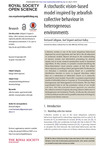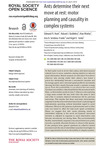Search
Now showing items 51-57 of 57
A stochastic vision-based model inspired by zebrafish collective behaviour in heterogeneous environments
(2016)
Collective motion is one of the most ubiquitous behaviours displayed by social organisms and has led to the development of numerous models. Recent advances in the understanding of sensory system and information processing ...
How far will a behaviourally flexible invasive bird go to innovate?
(2016)
Behavioural flexibility is considered a key factor in the ability to adapt to changing environments. A traditional way of characterizing behavioural flexibility is to determine whether individuals invent solutions to novel ...
Coexistence of three sympatric cormorants
(2016)
Resource partitioning is well known along food and habitat for reducing competition among sympatric species, yet a study on temporal partitioning as a viable basis for reducing resource competition is not empirically ...
Exploration adjustment Ants determine their next move at rest
(2016)
To find useful work to do for their colony, individual eusocial animals have to move, somehow staying attentive to relevant social information. Recent research on individual Temnothorax albipennis ants moving inside their ...
Estimation of self motion duration and distance in rodents
(2016)
Spatial orientation and navigation rely on information about landmarks and self-motion cues gained from multi-sensory sources. In this study, we focused on self-motion and examined the capability of rodents to extract and ...
Socially segregated sympatric spermwhale clans in the Atlantic Ocean
(2016)
Sperm whales (Physeter macrocephalus) are unusual in that there is good evidence for sympatric populations with distinct culturally determined behaviour, including potential acoustic markers of the population division. In ...
Ants determine their next move at rest
(2016)
To find useful work to do for their colony, individual eusocial animals have to move, somehow staying attentive to relevant social information. Recent research on individualTemnothorax albipennis ants moving inside their ...







